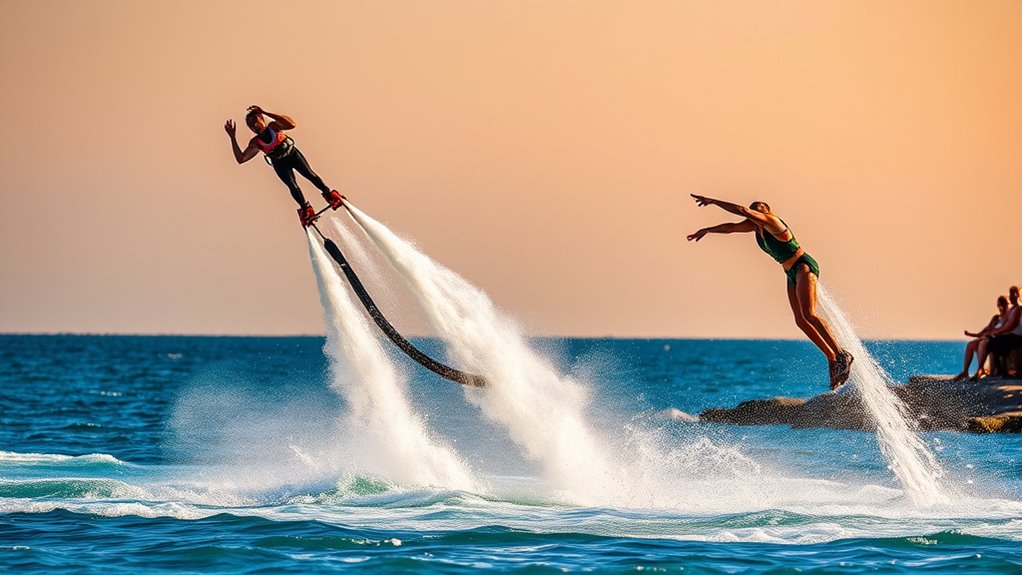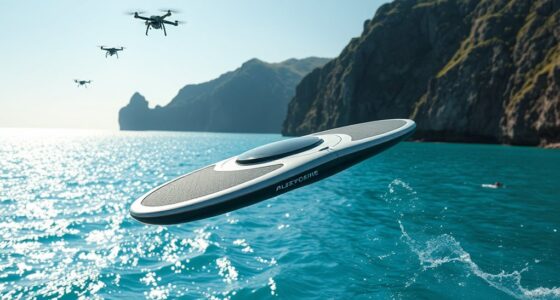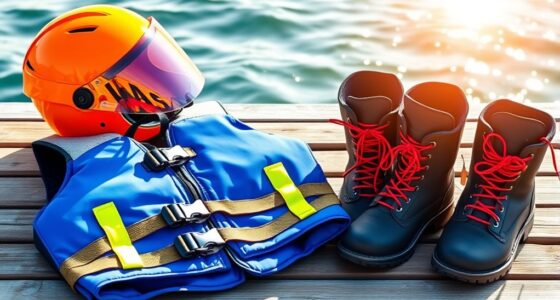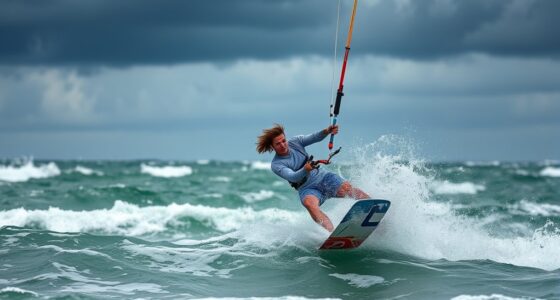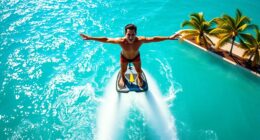Advanced flyboarding techniques like backflips and dolphin dives take your water experience to the next level. To master these moves, you need a solid foundation and excellent balance. For backflips, lean back and pull your knees to your chest, trusting the water jet for lift. For dolphin dives, dive forward with streamlined movements. Each trick builds confidence and skill, making the experience even more thrilling. Keep going, and you’ll discover more about conquering the skies above.
Key Takeaways
- Master basic flyboarding techniques to build a solid foundation before attempting advanced tricks like backflips and dolphin dives.
- Ensure proper safety equipment, including life jackets and helmets, to prevent injuries during advanced maneuvers.
- For backflips, lean backward and pull your knees to your chest while trusting the water jet for lift.
- Execute dolphin dives by gaining height and diving forward with a streamlined body to mimic a dolphin’s glide.
- Consistent practice enhances confidence and skill, allowing you to push boundaries and enjoy the thrill of advanced flyboarding.

Have you ever wondered what it feels like to soar above the water, twisting and flipping through the air? Flyboarding offers that exhilarating experience, and once you master the basics, you can start exploring the advanced techniques like backflips and dolphin dives. Not only do these moves look impressive, but they also give you a rush that’s hard to find anywhere else.
Experience the thrill of flyboarding—soar, twist, and master impressive tricks like backflips and dolphin dives for an unforgettable rush!
Before you plunge into performing these tricks, make sure you’ve got the right safety equipment. A properly fitting life jacket is essential, as it keeps you safe while you’re learning to control your movements. It’s also wise to wear a helmet to protect your head in case of a fall. Remember, safety first! Once you’re geared up, you’re ready to harness the power of water propulsion to take your flyboarding to the next level.
To begin with, backflips require a solid foundation. You’ll want to practice your balance and control while hovering above the water. Start by getting comfortable with the basic flyboarding stance, ensuring you can maintain stability while the water propulsion system propels you upwards. When you feel confident, initiate the backflip by leaning slightly backward while pulling your knees to your chest. The water jet will help launch you into the air, so trust the propulsion system to carry you. It might feel a bit intimidating at first, but with practice, you’ll soon find your rhythm.
Next up is the dolphin dive, a move that combines grace and strength. To execute this dive, you need to gain some height first. Use the water propulsion to elevate yourself, then dive forward while extending your arms and legs. Imagine a dolphin gliding through the water; that’s the motion you want to mimic. As you dive, keep your body streamlined to maximize your speed as you plunge into the water.
Mastering these advanced techniques isn’t just about the tricks themselves; it’s also about building confidence. Each successful attempt will boost your skills and encourage you to push your boundaries further. Embrace the thrill, enjoy the sensation of flying, and remember that practice makes perfect. With time, you’ll be flipping and diving like a pro, feeling the rush of wind and water as you conquer the skies above. Understanding the importance of safety equipment is crucial for a successful flyboarding experience. So gear up, hit the water, and let your flyboarding journey take flight!
Frequently Asked Questions
What Safety Gear Is Recommended for Flyboarding?
For flyboarding, you should wear protective equipment like a life vest, helmet, and water shoes. These items enhance your safety and help prevent injuries. It’s also essential to familiarize yourself with emergency procedures before hitting the water. Knowing how to handle potential issues, like losing control or falling, can make your experience much safer and more enjoyable. Prioritize safety gear to maximize your confidence while you fly above the water!
How Long Does It Take to Learn Advanced Maneuvers?
It typically takes several weeks to a few months to learn advanced maneuvers, depending on your background and commitment. The learning curve can be steep, but with consistent practice, you’ll see significant skill development. Regular sessions will help you build confidence and refine your techniques. Remember, everyone progresses at their own pace, so stay patient and focused on mastering each move before moving on to the next challenge.
Can Anyone Flyboard, or Are There Restrictions?
Yes, anyone can flyboard, but there are some restrictions. You’ll need to meet certain training prerequisites, like completing a beginner course and demonstrating basic skills. Fitness requirements are also important; you should be in good physical shape to handle the demands of the sport. If you’re under 18, parental consent may be necessary. Always check with your local flyboarding facility for specific guidelines before you hit the water!
What Is the Cost of a Flyboarding Session?
The cost of a flyboarding session typically ranges from $100 to $250, depending on where you’re located and the duration of the session. Many places offer discounts for longer sessions or group bookings, so it’s worth checking their pricing options. You’ll want to factor in any rental gear fees too. Just remember, investing in a flyboarding session could lead to an unforgettable experience, so it’s often worth the splurge!
Are There Age Limits for Flyboarding Participants?
You’ll be thrilled to know there aren’t age restrictions that’ll make you feel ancient when it comes to flyboarding. Generally, participants must be at least 10 years old, but younger kids might be permitted with parental consent. Beginner limitations might apply, so you’ll want to check with your local flyboarding provider. They’ll ensure you’re ready for the adventure, regardless of whether you’re a young daredevil or a seasoned thrill-seeker!
Conclusion
In summary, mastering advanced flyboarding techniques like backflips and dolphin dives isn’t just about skill; it’s also a matter of understanding physics. The theory that a precise balance of weight distribution and water propulsion can enhance aerial maneuvers holds true. By perfecting your technique and harnessing these principles, you can elevate your flyboarding experience. So, next time you’re soaring above the water, remember that your body’s movements and the forces at play are key to your success.

